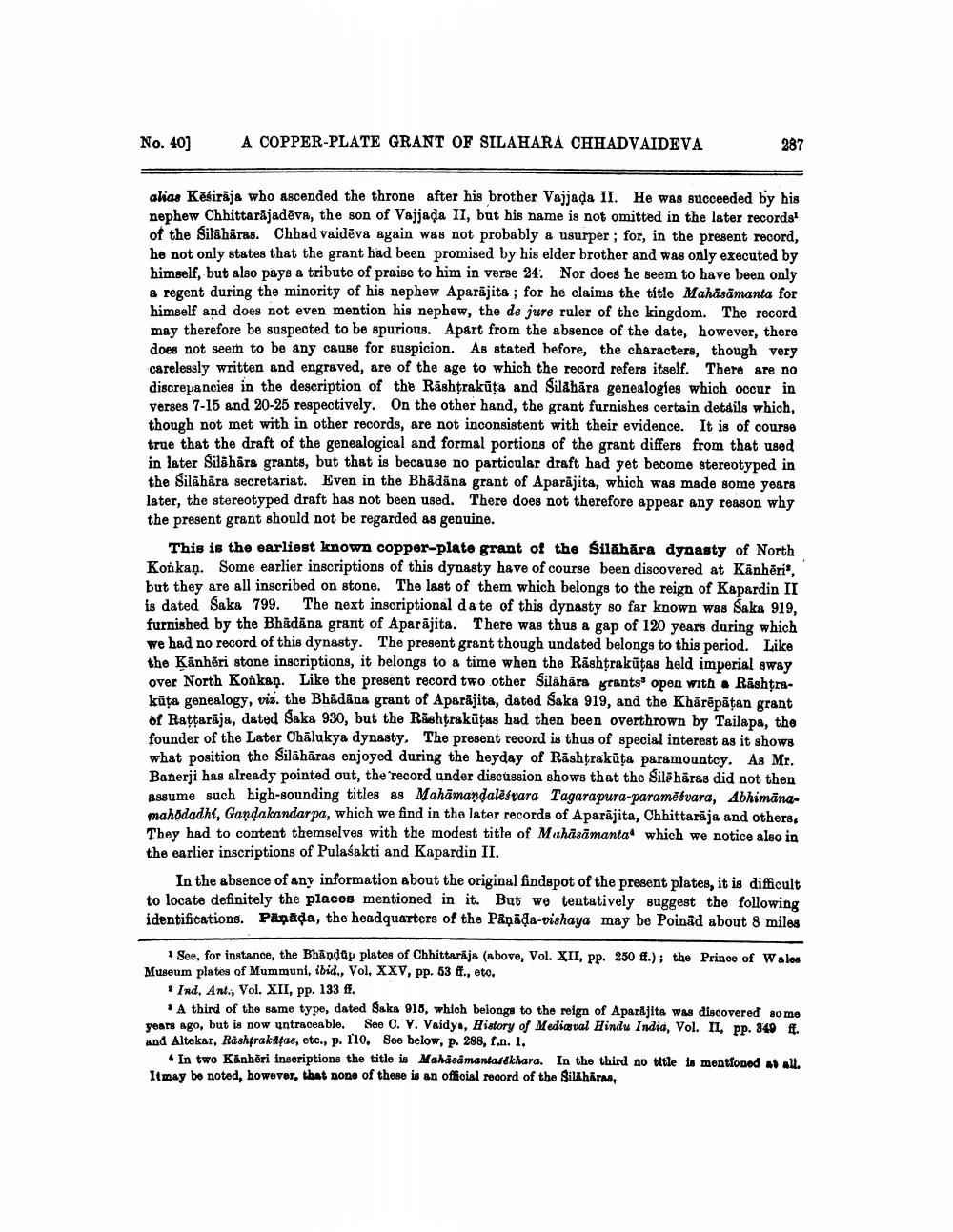________________
No. 40]
A COPPER-PLATE GRANT OF SILAHARA CHHADVAIDEVA
287
alias Kesiraja who ascended the throne after his brother Vajjada II. He was succeeded by his nephew Chhittarajadeva, the son of Vajjada II, but his name is not omitted in the later records1 of the Silähäras. Chhad vaidēva again was not probably a usurper; for, in the present record, he not only states that the grant had been promised by his elder brother and was only executed by himself, but also pays a tribute of praise to him in verse 24. Nor does he seem to have been only a regent during the minority of his nephew Aparajita; for he claims the title Mahāsāmanta for himself and does not even mention his nephew, the de jure ruler of the kingdom. The record may therefore be suspected to be spurious. Apart from the absence of the date, however, there does not seem to be any cause for suspicion. As stated before, the characters, though very carelessly written and engraved, are of the age to which the record refers itself. There are no discrepancies in the description of the Rashtrakuta and Silahara genealogies which occur in verses 7-15 and 20-25 respectively. On the other hand, the grant furnishes certain details which, though not met with in other records, are not inconsistent with their evidence. It is of course true that the draft of the genealogical and formal portions of the grant differs from that used in later Silahāra grants, but that is because no particular draft had yet become stereotyped in the Silahāra secretariat. Even in the Bhadana grant of Aparajita, which was made some years later, the stereotyped draft has not been used. There does not therefore appear any reason why the present grant should not be regarded as genuine.
This is the earliest known copper-plate grant of the Silahara dynasty of North Konkan. Some earlier inscriptions of this dynasty have of course been discovered at Kanheri", but they are all inscribed on stone. The last of them which belongs to the reign of Kapardin II is dated Saka 799. The next inscriptional date of this dynasty so far known was Saka 919, furnished by the Bhadana grant of Aparajita. There was thus a gap of 120 years during which we had no record of this dynasty. The present grant though undated belongs to this period. Like the Kanheri stone inscriptions, it belongs to a time when the Rashtrakutas held imperial sway over North Konkan. Like the present record two other Silahāra grants open with a Rashtrakūta genealogy, viz. the Bhadana grant of Aparajita, dated Saka 919, and the Khārēpāṭan grant of Raṭṭaraja, dated Saka 930, but the Rashtrakutas had then been overthrown by Tailapa, the founder of the Later Chalukya dynasty. The present record is thus of special interest as it shows what position the Silahāras enjoyed during the heyday of Rashtrakuta paramountcy. As Mr. Banerji has already pointed out, the record under discussion shows that the Silahāras did not then assume such high-sounding titles as Mahamandalesvara Tagarapura-paramesvara, Abhimanamahodadhi, Gandakandarpa, which we find in the later records of Aparajita, Chhittaraja and others. They had to content themselves with the modest title of Mahasamanta which we notice also in the earlier inscriptions of Pulaśakti and Kapardin II.
In the absence of any information about the original findspot of the present plates, it is difficult to locate definitely the places mentioned in it. But we tentatively suggest the following identifications. Papada, the headquarters of the Papada-vishaya may be Poinad about 8 miles
1 See, for instance, the Bhandup plates of Chhittaraja (above, Vol. XII, pp. 250 ft.); the Prince of Wales Museum plates of Mummuni, ibid., Vol, XXV, pp. 53 ff., etc.
Ind, Ant., Vol. XII, pp. 133 ff.
A third of the same type, dated Saka 915, which belongs to the reign of Aparajita was discovered some years ago, but is now untraceable. See C. V. Vaidya, History of Medieval Hindu India, Vol. II, pp. 349 ft. and Altekar, Rashtrakutas, etc., p. 110. See below, p. 288, f.n. 1.
In two Kanheri inscriptions the title is Mahasamantasekhara. In the third no title is mentioned at all. It may be noted, however, that none of these is an official record of the Silähäras,




